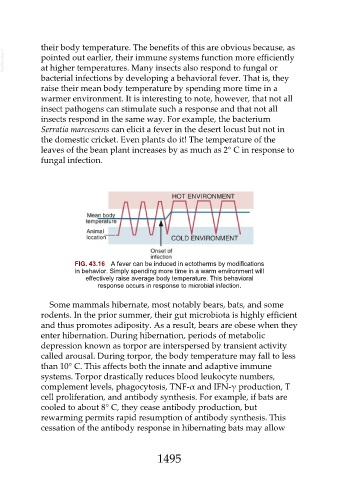Page 1495 - Veterinary Immunology, 10th Edition
P. 1495
their body temperature. The benefits of this are obvious because, as
VetBooks.ir pointed out earlier, their immune systems function more efficiently
at higher temperatures. Many insects also respond to fungal or
bacterial infections by developing a behavioral fever. That is, they
raise their mean body temperature by spending more time in a
warmer environment. It is interesting to note, however, that not all
insect pathogens can stimulate such a response and that not all
insects respond in the same way. For example, the bacterium
Serratia marcescens can elicit a fever in the desert locust but not in
the domestic cricket. Even plants do it! The temperature of the
leaves of the bean plant increases by as much as 2° C in response to
fungal infection.
FIG. 43.16 A fever can be induced in ectotherms by modifications
in behavior. Simply spending more time in a warm environment will
effectively raise average body temperature. This behavioral
response occurs in response to microbial infection.
Some mammals hibernate, most notably bears, bats, and some
rodents. In the prior summer, their gut microbiota is highly efficient
and thus promotes adiposity. As a result, bears are obese when they
enter hibernation. During hibernation, periods of metabolic
depression known as torpor are interspersed by transient activity
called arousal. During torpor, the body temperature may fall to less
than 10° C. This affects both the innate and adaptive immune
systems. Torpor drastically reduces blood leukocyte numbers,
complement levels, phagocytosis, TNF-α and IFN-γ production, T
cell proliferation, and antibody synthesis. For example, if bats are
cooled to about 8° C, they cease antibody production, but
rewarming permits rapid resumption of antibody synthesis. This
cessation of the antibody response in hibernating bats may allow
1495

